technical specifications FIAT LINEA 2007 1.G Owners Manual
[x] Cancel search | Manufacturer: FIAT, Model Year: 2007, Model line: LINEA, Model: FIAT LINEA 2007 1.GPages: 230, PDF Size: 3.31 MB
Page 115 of 230
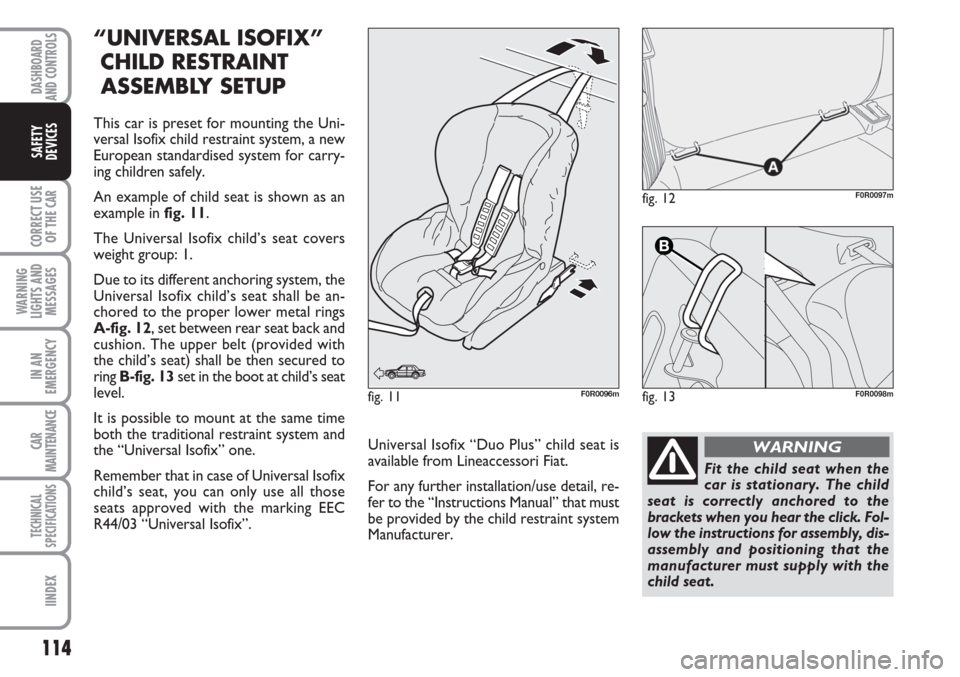
114
CORRECT USE
OF THE
CAR
WARNING
LIGHTS AND
MESSAGES
IN AN
EMERGENCY
CAR
MAINTENANCE
TECHNICAL
SPECIFICATIONS
IINDEX
DASHBOARD
AND CONTROLS
SAFETY
DEVICES
“UNIVERSAL ISOFIX”
CHILD RESTRAINT
ASSEMBLY SETUP
This car is preset for mounting the Uni-
versal Isofix child restraint system, a new
European standardised system for carry-
ing children safely.
An example of child seat is shown as an
example in fig. 11.
The Universal Isofix child’s seat covers
weight group: 1.
Due to its different anchoring system, the
Universal Isofix child’s seat shall be an-
chored to the proper lower metal rings
A-fig. 12, set between rear seat back and
cushion. The upper belt (provided with
the child’s seat) shall be then secured to
ring B-fig. 13set in the boot at child’s seat
level.
It is possible to mount at the same time
both the traditional restraint system and
the “Universal Isofix” one.
Remember that in case of Universal Isofix
child’s seat, you can only use all those
seats approved with the marking EEC
R44/03 “Universal Isofix”.
fig. 12F0R0097m
fig. 11F0R0096mfig. 13F0R0098m
Fit the child seat when the
car is stationary. The child
seat is correctly anchored to the
brackets when you hear the click. Fol-
low the instructions for assembly, dis-
assembly and positioning that the
manufacturer must supply with the
child seat.
WARNINGUniversal Isofix “Duo Plus” child seat is
available from Lineaccessori Fiat.
For any further installation/use detail, re-
fer to the “Instructions Manual” that must
be provided by the child restraint system
Manufacturer.
Page 116 of 230
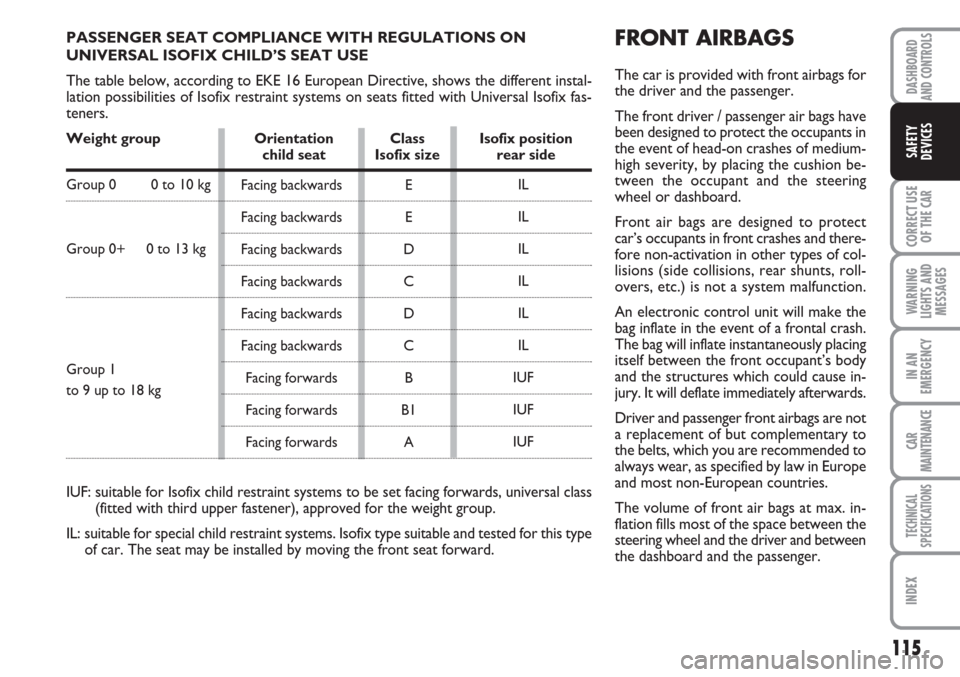
115
CORRECT USE
OF THE
CAR
WARNING
LIGHTS AND
MESSAGES
IN AN
EMERGENCY
CAR
MAINTENANCE
TECHNICAL
SPECIFICATIONS
INDEX
DASHBOARD
AND CONTROLS
SAFETY
DEVICES
FRONT AIRBAGS
The car is provided with front airbags for
the driver and the passenger.
The front driver / passenger air bags have
been designed to protect the occupants in
the event of head-on crashes of medium-
high severity, by placing the cushion be-
tween the occupant and the steering
wheel or dashboard.
Front air bags are designed to protect
car’s occupants in front crashes and there-
fore non-activation in other types of col-
lisions (side collisions, rear shunts, roll-
overs, etc.) is not a system malfunction.
An electronic control unit will make the
bag inflate in the event of a frontal crash.
The bag will inflate instantaneously placing
itself between the front occupant’s body
and the structures which could cause in-
jury. It will deflate immediately afterwards.
Driver and passenger front airbags are not
a replacement of but complementary to
the belts, which you are recommended to
always wear, as specified by law in Europe
and most non-European countries.
The volume of front air bags at max. in-
flation fills most of the space between the
steering wheel and the driver and between
the dashboard and the passenger.
E
E
D
C
D
C
B
B1
A
PASSENGER SEAT COMPLIANCE WITH REGULATIONS ON
UNIVERSAL ISOFIX CHILD’S SEAT USE
The table below, according to EKE 16 European Directive, shows the different instal-
lation possibilities of Isofix restraint systems on seats fitted with Universal Isofix fas-
teners.
Weight group Orientation Class Isofix position child seat Isofix size rear side
Group 0 0 to 10 kg
Group 0+ 0 to 13 kg
Group 1
to 9 up to 18 kg
IUF: suitable for Isofix child restraint systems to be set facing forwards, universal class
(fitted with third upper fastener), approved for the weight group.
IL: suitable for special child restraint systems. Isofix type suitable and tested for this type
of car. The seat may be installed by moving the front seat forward.
IL
IL
IL
IL
IL
IL
IUF
IUF
IUF Facing backwards
Facing backwards
Facing backwards
Facing backwards
Facing backwards
Facing backwards
Facing forwards
Facing forwards
Facing forwards
Page 117 of 230
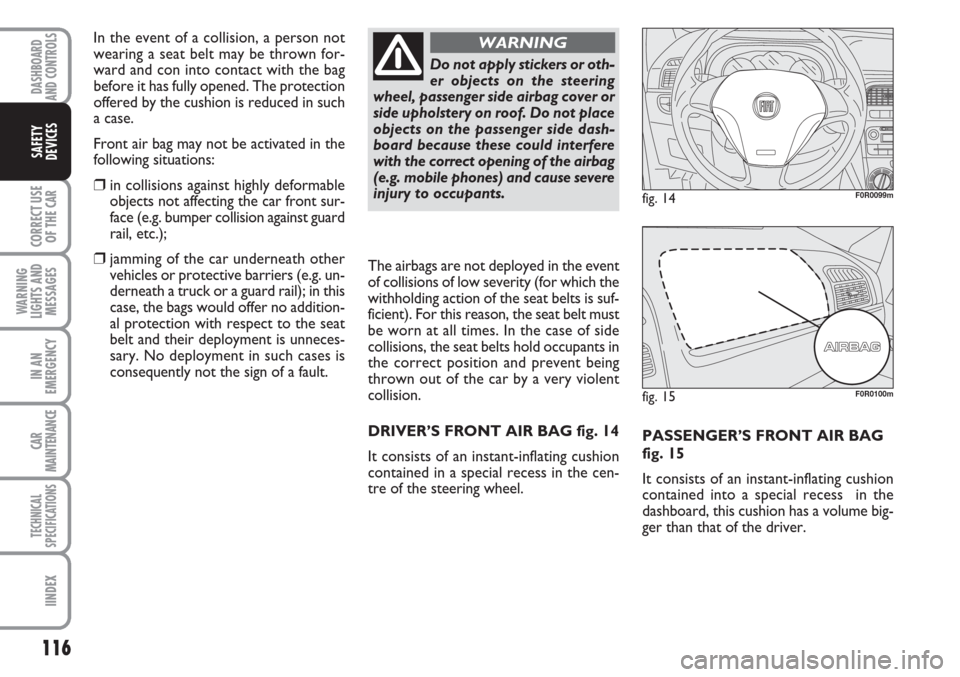
116
CORRECT USE
OF THE
CAR
WARNING
LIGHTS AND
MESSAGES
IN AN
EMERGENCY
CAR
MAINTENANCE
TECHNICAL
SPECIFICATIONS
IINDEX
DASHBOARD
AND CONTROLS
SAFETY
DEVICES
PASSENGER’S FRONT AIR BAG
fig. 15
It consists of an instant-inflating cushion
contained into a special recess in the
dashboard, this cushion has a volume big-
ger than that of the driver.
fig. 14F0R0099m
fig. 15F0R0100m
The airbags are not deployed in the event
of collisions of low severity (for which the
withholding action of the seat belts is suf-
ficient). For this reason, the seat belt must
be worn at all times. In the case of side
collisions, the seat belts hold occupants in
the correct position and prevent being
thrown out of the car by a very violent
collision.
DRIVER’S FRONT AIR BAG fig. 14
It consists of an instant-inflating cushion
contained in a special recess in the cen-
tre of the steering wheel.
Do not apply stickers or oth-
er objects on the steering
wheel, passenger side airbag cover or
side upholstery on roof. Do not place
objects on the passenger side dash-
board because these could interfere
with the correct opening of the airbag
(e.g. mobile phones) and cause severe
injury to occupants.
WARNINGIn the event of a collision, a person not
wearing a seat belt may be thrown for-
ward and con into contact with the bag
before it has fully opened. The protection
offered by the cushion is reduced in such
a case.
Front air bag may not be activated in the
following situations:
❒in collisions against highly deformable
objects not affecting the car front sur-
face (e.g. bumper collision against guard
rail, etc.);
❒jamming of the car underneath other
vehicles or protective barriers (e.g. un-
derneath a truck or a guard rail); in this
case, the bags would offer no addition-
al protection with respect to the seat
belt and their deployment is unneces-
sary. No deployment in such cases is
consequently not the sign of a fault.
Page 118 of 230
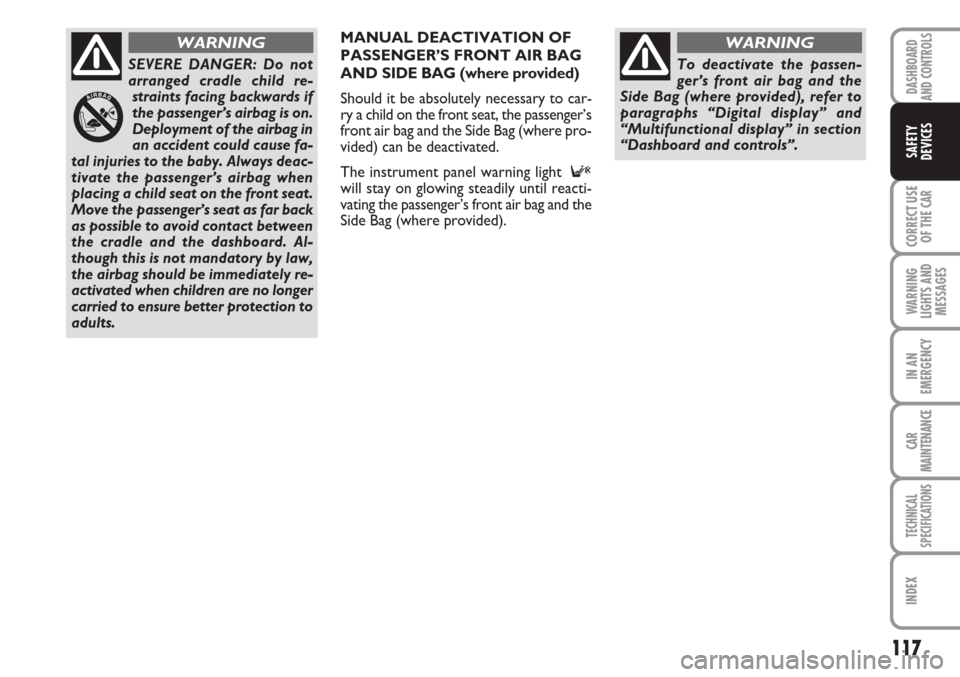
117
CORRECT USE
OF THE
CAR
WARNING
LIGHTS AND
MESSAGES
IN AN
EMERGENCY
CAR
MAINTENANCE
TECHNICAL
SPECIFICATIONS
INDEX
DASHBOARD
AND CONTROLS
SAFETY
DEVICES
MANUAL DEACTIVATION OF
PASSENGER’S FRONT AIR BAG
AND SIDE BAG (where provided)
Should it be absolutely necessary to car-
ry a child on the front seat, the passenger’s
front air bag and the Side Bag (where pro-
vided) can be deactivated.
The instrument panel warning light
Fwill stay on glowing steadily until reacti-
vating the passenger’s front air bag and the
Side Bag (where provided).
SEVERE DANGER: Do not
arranged cradle child re-
straints facing backwards if
the passenger’s airbag is on.
Deployment of the airbag in
an accident could cause fa-
tal injuries to the baby. Always deac-
tivate the passenger’s airbag when
placing a child seat on the front seat.
Move the passenger’s seat as far back
as possible to avoid contact between
the cradle and the dashboard. Al-
though this is not mandatory by law,
the airbag should be immediately re-
activated when children are no longer
carried to ensure better protection to
adults.
WARNING
To deactivate the passen-
ger’s front air bag and the
Side Bag (where provided), refer to
paragraphs “Digital display” and
“Multifunctional display” in section
“Dashboard and controls”.
WARNING
Page 119 of 230
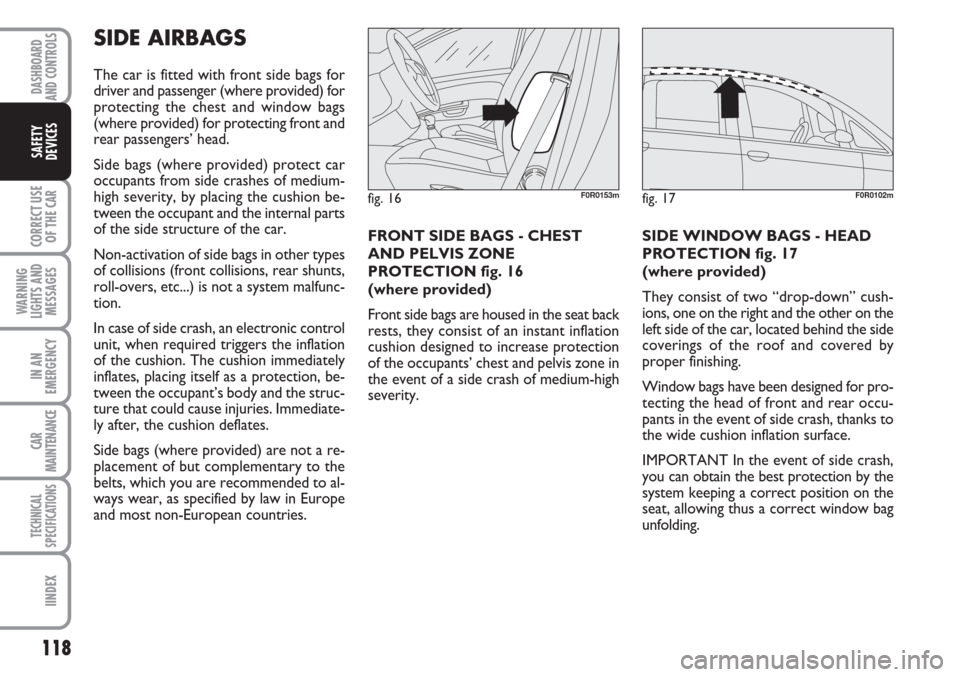
118
CORRECT USE
OF THE
CAR
WARNING
LIGHTS AND
MESSAGES
IN AN
EMERGENCY
CAR
MAINTENANCE
TECHNICAL
SPECIFICATIONS
IINDEX
DASHBOARD
AND CONTROLS
SAFETY
DEVICES
SIDE AIRBAGS
The car is fitted with front side bags for
driver and passenger (where provided) for
protecting the chest and window bags
(where provided) for protecting front and
rear passengers’ head.
Side bags (where provided) protect car
occupants from side crashes of medium-
high severity, by placing the cushion be-
tween the occupant and the internal parts
of the side structure of the car.
Non-activation of side bags in other types
of collisions (front collisions, rear shunts,
roll-overs, etc...) is not a system malfunc-
tion.
In case of side crash, an electronic control
unit, when required triggers the inflation
of the cushion. The cushion immediately
inflates, placing itself as a protection, be-
tween the occupant’s body and the struc-
ture that could cause injuries. Immediate-
ly after, the cushion deflates.
Side bags (where provided) are not a re-
placement of but complementary to the
belts, which you are recommended to al-
ways wear, as specified by law in Europe
and most non-European countries.FRONT SIDE BAGS - CHEST
AND PELVIS ZONE
PROTECTION fig. 16
(where provided)
Front side bags are housed in the seat back
rests, they consist of an instant inflation
cushion designed to increase protection
of the occupants’ chest and pelvis zone in
the event of a side crash of medium-high
severity.SIDE WINDOW BAGS - HEAD
PROTECTION fig. 17
(where provided)
They consist of two “drop-down” cush-
ions, one on the right and the other on the
left side of the car, located behind the side
coverings of the roof and covered by
proper finishing.
Window bags have been designed for pro-
tecting the head of front and rear occu-
pants in the event of side crash, thanks to
the wide cushion inflation surface.
IMPORTANT In the event of side crash,
you can obtain the best protection by the
system keeping a correct position on the
seat, allowing thus a correct window bag
unfolding.
fig. 16F0R0153mfig. 17F0R0102m
Page 120 of 230
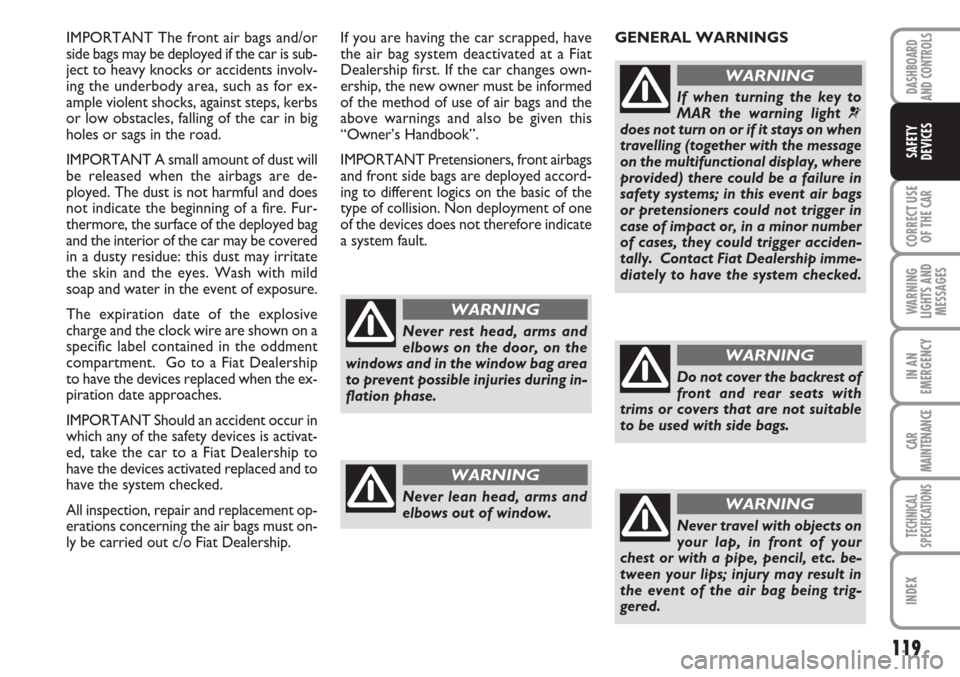
119
CORRECT USE
OF THE
CAR
WARNING
LIGHTS AND
MESSAGES
IN AN
EMERGENCY
CAR
MAINTENANCE
TECHNICAL
SPECIFICATIONS
INDEX
DASHBOARD
AND CONTROLS
SAFETY
DEVICES
IMPORTANT The front air bags and/or
side bags may be deployed if the car is sub-
ject to heavy knocks or accidents involv-
ing the underbody area, such as for ex-
ample violent shocks, against steps, kerbs
or low obstacles, falling of the car in big
holes or sags in the road.
IMPORTANT A small amount of dust will
be released when the airbags are de-
ployed. The dust is not harmful and does
not indicate the beginning of a fire. Fur-
thermore, the surface of the deployed bag
and the interior of the car may be covered
in a dusty residue: this dust may irritate
the skin and the eyes. Wash with mild
soap and water in the event of exposure.
The expiration date of the explosive
charge and the clock wire are shown on a
specific label contained in the oddment
compartment. Go to a Fiat Dealership
to have the devices replaced when the ex-
piration date approaches.
IMPORTANT Should an accident occur in
which any of the safety devices is activat-
ed, take the car to a Fiat Dealership to
have the devices activated replaced and to
have the system checked.
All inspection, repair and replacement op-
erations concerning the air bags must on-
ly be carried out c/o Fiat Dealership.If you are having the car scrapped, have
the air bag system deactivated at a Fiat
Dealership first. If the car changes own-
ership, the new owner must be informed
of the method of use of air bags and the
above warnings and also be given this
“Owner’s Handbook”.
IMPORTANT Pretensioners, front airbags
and front side bags are deployed accord-
ing to different logics on the basic of the
type of collision. Non deployment of one
of the devices does not therefore indicate
a system fault.
Never rest head, arms and
elbows on the door, on the
windows and in the window bag area
to prevent possible injuries during in-
flation phase.
WARNING
Never lean head, arms and
elbows out of window.
WARNING
GENERAL WARNINGS
If when turning the key to
MAR the warning light ¬does not turn on or if it stays on when
travelling (together with the message
on the multifunctional display, where
provided) there could be a failure in
safety systems; in this event air bags
or pretensioners could not trigger in
case of impact or, in a minor number
of cases, they could trigger acciden-
tally. Contact Fiat Dealership imme-
diately to have the system checked.
WARNING
Do not cover the backrest of
front and rear seats with
trims or covers that are not suitable
to be used with side bags.
WARNING
Never travel with objects on
your lap, in front of your
chest or with a pipe, pencil, etc. be-
tween your lips; injury may result in
the event of the air bag being trig-
gered.
WARNING
Page 121 of 230
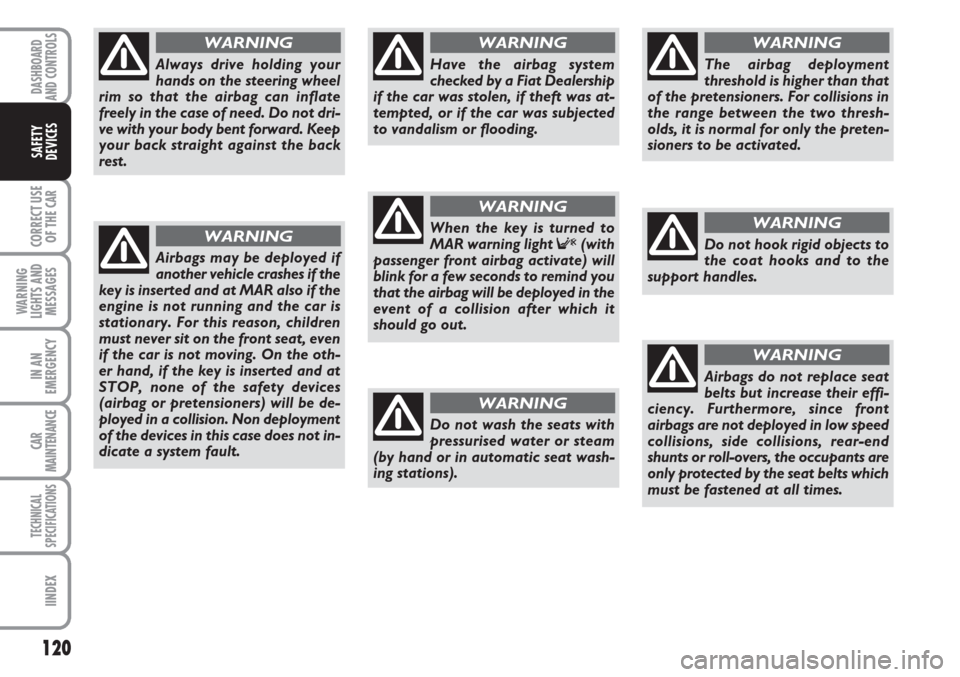
120
CORRECT USE
OF THE
CAR
WARNING
LIGHTS AND
MESSAGES
IN AN
EMERGENCY
CAR
MAINTENANCE
TECHNICAL
SPECIFICATIONS
IINDEX
DASHBOARD
AND CONTROLS
SAFETY
DEVICES
Always drive holding your
hands on the steering wheel
rim so that the airbag can inflate
freely in the case of need. Do not dri-
ve with your body bent forward. Keep
your back straight against the back
rest.
WARNING
Airbags may be deployed if
another vehicle crashes if the
key is inserted and at MAR also if the
engine is not running and the car is
stationary. For this reason, children
must never sit on the front seat, even
if the car is not moving. On the oth-
er hand, if the key is inserted and at
STOP, none of the safety devices
(airbag or pretensioners) will be de-
ployed in a collision. Non deployment
of the devices in this case does not in-
dicate a system fault.
WARNING
Do not wash the seats with
pressurised water or steam
(by hand or in automatic seat wash-
ing stations).
WARNING
The airbag deployment
threshold is higher than that
of the pretensioners. For collisions in
the range between the two thresh-
olds, it is normal for only the preten-
sioners to be activated.
WARNING
Do not hook rigid objects to
the coat hooks and to the
support handles.
WARNING
Airbags do not replace seat
belts but increase their effi-
ciency. Furthermore, since front
airbags are not deployed in low speed
collisions, side collisions, rear-end
shunts or roll-overs, the occupants are
only protected by the seat belts which
must be fastened at all times.
WARNING
When the key is turned to
MAR warning light F(with
passenger front airbag activate) will
blink for a few seconds to remind you
that the airbag will be deployed in the
event of a collision after which it
should go out.
WARNING
Have the airbag system
checked by a Fiat Dealership
if the car was stolen, if theft was at-
tempted, or if the car was subjected
to vandalism or flooding.
WARNING
Page 122 of 230
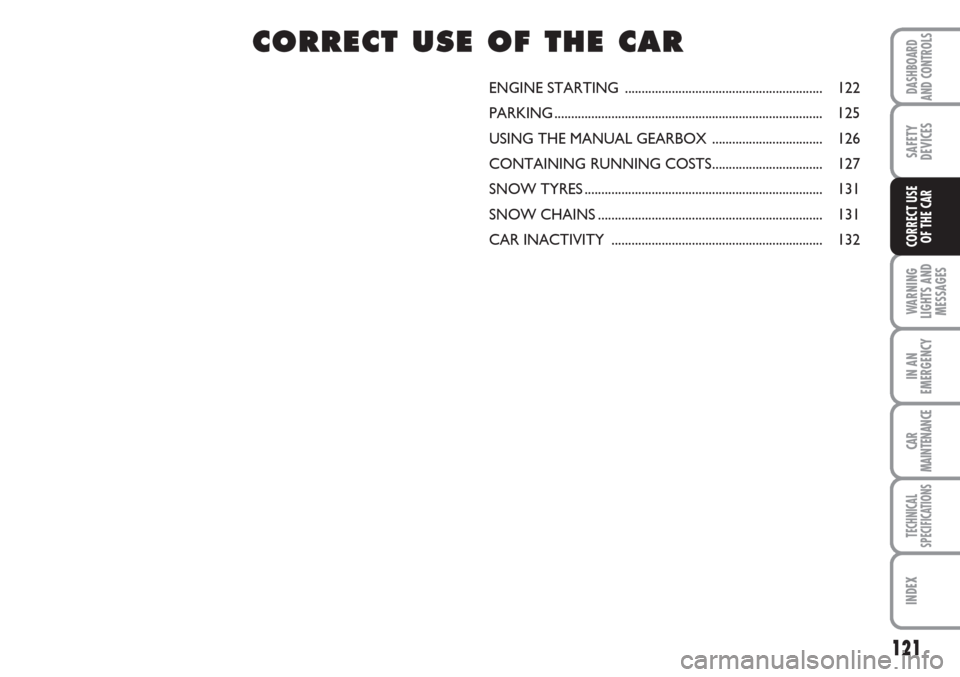
121
WARNING
LIGHTS AND
MESSAGES
IN AN
EMERGENCY
CAR
MAINTENANCE
TECHNICAL
SPECIFICATIONS
INDEX
DASHBOARD
AND CONTROLS
SAFETY
DEVICES
CORRECT USE
OF THE CAR
ENGINE STARTING ........................................................... 122
PARKING................................................................................ 125
USING THE MANUAL GEARBOX ................................. 126
CONTAINING RUNNING COSTS................................. 127
SNOW TYRES....................................................................... 131
SNOW CHAINS................................................................... 131
CAR INACTIVITY ............................................................... 132
CC C
O O
R R
R R
E E
C C
T T
U U
S S
E E
O O
F F
T T
H H
E E
C C
A A
R R
Page 123 of 230
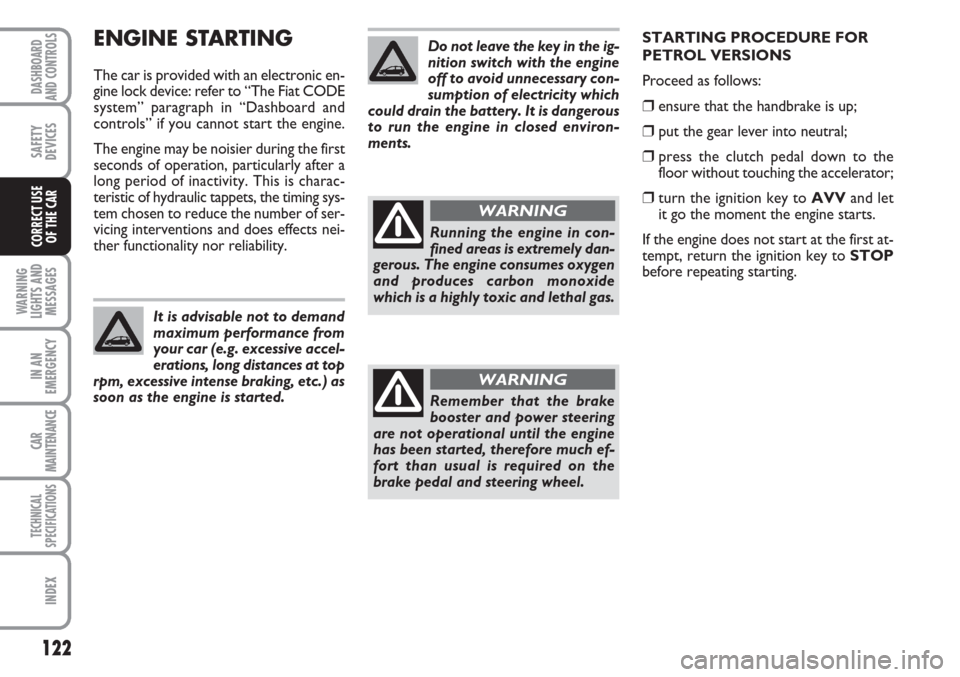
122
WARNING
LIGHTS AND
MESSAGES
IN AN
EMERGENCY
CAR
MAINTENANCE
TECHNICAL
SPECIFICATIONS
INDEX
DASHBOARD
AND CONTROLS
SAFETY
DEVICES
CORRECT USE
OF THE CAR
ENGINE STARTING
The car is provided with an electronic en-
gine lock device: refer to “The Fiat CODE
system” paragraph in “Dashboard and
controls” if you cannot start the engine.
The engine may be noisier during the first
seconds of operation, particularly after a
long period of inactivity. This is charac-
teristic of hydraulic tappets, the timing sys-
tem chosen to reduce the number of ser-
vicing interventions and does effects nei-
ther functionality nor reliability.
It is advisable not to demand
maximum performance from
your car (e.g. excessive accel-
erations, long distances at top
rpm, excessive intense braking, etc.) as
soon as the engine is started.
Do not leave the key in the ig-
nition switch with the engine
off to avoid unnecessary con-
sumption of electricity which
could drain the battery. It is dangerous
to run the engine in closed environ-
ments.
Running the engine in con-
fined areas is extremely dan-
gerous. The engine consumes oxygen
and produces carbon monoxide
which is a highly toxic and lethal gas.
WARNING
Remember that the brake
booster and power steering
are not operational until the engine
has been started, therefore much ef-
fort than usual is required on the
brake pedal and steering wheel.
WARNING
STARTING PROCEDURE FOR
PETROL VERSIONS
Proceed as follows:
❒ensure that the handbrake is up;
❒put the gear lever into neutral;
❒press the clutch pedal down to the
floor without touching the accelerator;
❒turn the ignition key to AVVand let
it go the moment the engine starts.
If the engine does not start at the first at-
tempt, return the ignition key to STOP
before repeating starting.
Page 124 of 230
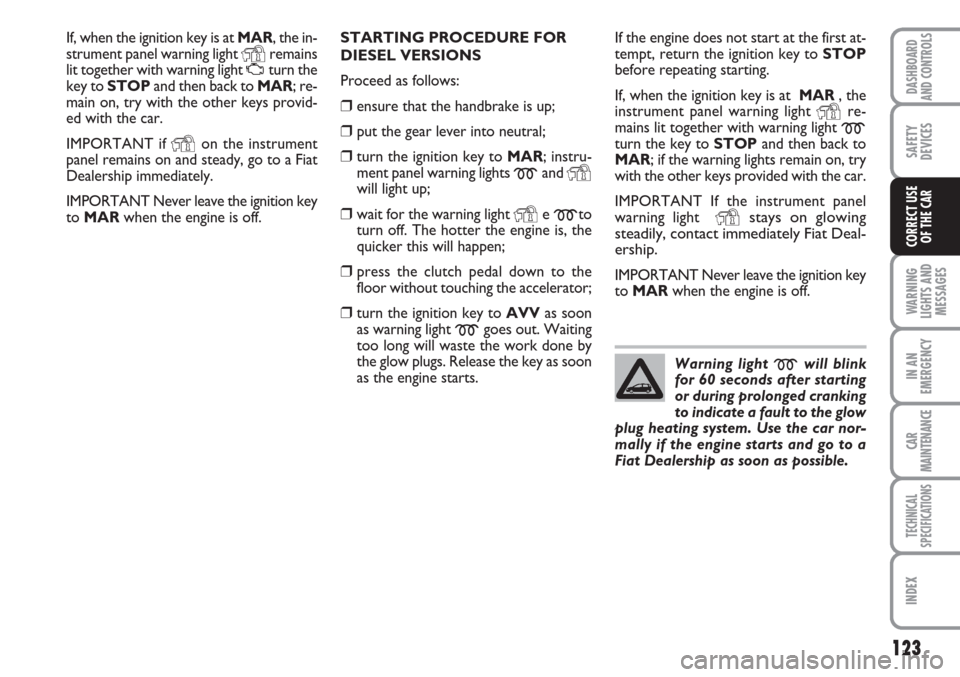
123
WARNING
LIGHTS AND
MESSAGES
IN AN
EMERGENCY
CAR
MAINTENANCE
TECHNICAL
SPECIFICATIONS
INDEX
DASHBOARD
AND CONTROLS
SAFETY
DEVICES
CORRECT USE
OF THE CAR
If, when the ignition key is at MAR, the in-
strument panel warning light
Yremains
lit together with warning light Uturn the
key to STOPand then back to MAR; re-
main on, try with the other keys provid-
ed with the car.
IMPORTANT if
Yon the instrument
panel remains on and steady, go to a Fiat
Dealership immediately.
IMPORTANT Never leave the ignition key
to MARwhen the engine is off.STARTING PROCEDURE FOR
DIESEL VERSIONS
Proceed as follows:
❒ensure that the handbrake is up;
❒put the gear lever into neutral;
❒turn the ignition key to MAR; instru-
ment panel warning lights
mand Ywill light up;
❒wait for the warning light Ye mto
turn off. The hotter the engine is, the
quicker this will happen;
❒press the clutch pedal down to the
floor without touching the accelerator;
❒turn the ignition key to AVVas soon
as warning light
mgoes out. Waiting
too long will waste the work done by
the glow plugs. Release the key as soon
as the engine starts.If the engine does not start at the first at-
tempt, return the ignition key to STOP
before repeating starting.
If, when the ignition key is at MAR, the
instrument panel warning light
Yre-
mains lit together with warning light
mturn the key to STOPand then back to
MAR; if the warning lights remain on, try
with the other keys provided with the car.
IMPORTANT If the instrument panel
warning light
Ystays on glowing
steadily, contact immediately Fiat Deal-
ership.
IMPORTANT Never leave the ignition key
to MARwhen the engine is off.
Warning light
mwill blink
for 60 seconds after starting
or during prolonged cranking
to indicate a fault to the glow
plug heating system. Use the car nor-
mally if the engine starts and go to a
Fiat Dealership as soon as possible.